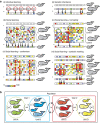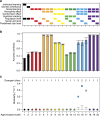Multilevel animal societies can emerge from cultural transmission
- PMID: 26348688
- PMCID: PMC4569709
- DOI: 10.1038/ncomms9091
Multilevel animal societies can emerge from cultural transmission
Abstract
Multilevel societies, containing hierarchically nested social levels, are remarkable social structures whose origins are unclear. The social relationships of sperm whales are organized in a multilevel society with an upper level composed of clans of individuals communicating using similar patterns of clicks (codas). Using agent-based models informed by an 18-year empirical study, we show that clans are unlikely products of stochastic processes (genetic or cultural drift) but likely originate from cultural transmission via biased social learning of codas. Distinct clusters of individuals with similar acoustic repertoires, mirroring the empirical clans, emerge when whales learn preferentially the most common codas (conformism) from behaviourally similar individuals (homophily). Cultural transmission seems key in the partitioning of sperm whales into sympatric clans. These findings suggest that processes similar to those that generate complex human cultures could not only be at play in non-human societies but also create multilevel social structures in the wild.
Figures




Similar articles
-
Vocal clans in sperm whales (Physeter macrocephalus).Proc Biol Sci. 2003 Feb 7;270(1512):225-31. doi: 10.1098/rspb.2002.2239. Proc Biol Sci. 2003. PMID: 12614570 Free PMC article.
-
Evidence from sperm whale clans of symbolic marking in non-human cultures.Proc Natl Acad Sci U S A. 2022 Sep 13;119(37):e2201692119. doi: 10.1073/pnas.2201692119. Epub 2022 Sep 8. Proc Natl Acad Sci U S A. 2022. PMID: 36074817 Free PMC article.
-
Sperm whale codas may encode individuality as well as clan identity.J Acoust Soc Am. 2016 May;139(5):2860. doi: 10.1121/1.4949478. J Acoust Soc Am. 2016. PMID: 27250178
-
Sperm whale clans and human societies.R Soc Open Sci. 2024 Jan 10;11(1):231353. doi: 10.1098/rsos.231353. eCollection 2024 Jan. R Soc Open Sci. 2024. PMID: 38204796 Free PMC article. Review.
-
The interplay between social networks and culture: theoretically and among whales and dolphins.Philos Trans R Soc Lond B Biol Sci. 2013 Apr 8;368(1618):20120340. doi: 10.1098/rstb.2012.0340. Print 2013 May 19. Philos Trans R Soc Lond B Biol Sci. 2013. PMID: 23569288 Free PMC article. Review.
Cited by
-
Why intergroup variation matters for understanding behaviour.Biol Lett. 2019 Nov 29;15(11):20190695. doi: 10.1098/rsbl.2019.0695. Epub 2019 Nov 13. Biol Lett. 2019. PMID: 31718514 Free PMC article.
-
Chimpanzees use social information to acquire a skill they fail to innovate.Nat Hum Behav. 2024 May;8(5):891-902. doi: 10.1038/s41562-024-01836-5. Epub 2024 Mar 6. Nat Hum Behav. 2024. PMID: 38448718 Free PMC article.
-
Copy-the-majority of instances or individuals? Two approaches to the majority and their consequences for conformist decision-making.PLoS One. 2019 Jan 25;14(1):e0210748. doi: 10.1371/journal.pone.0210748. eCollection 2019. PLoS One. 2019. PMID: 30682728 Free PMC article.
-
Sociality and Wild Animal Welfare: Future Directions.Front Vet Sci. 2019 Mar 19;6:62. doi: 10.3389/fvets.2019.00062. eCollection 2019. Front Vet Sci. 2019. PMID: 30941354 Free PMC article. Review.
-
The costs and benefits of decentralization and centralization of ant colonies.Behav Ecol. 2019 Nov-Dec;30(6):1700-1706. doi: 10.1093/beheco/arz138. Epub 2019 Aug 14. Behav Ecol. 2019. PMID: 31723318 Free PMC article.
References
-
- Hinde R. A. Interactions, relationships and social structure. Man 11, 1–17 (1976).
-
- Clutton-Brock T. H. Review lecture: mammalian mating systems. Proc. R. Soc. B 236, 339–372 (1989). - PubMed
Publication types
MeSH terms
LinkOut - more resources
Full Text Sources
Other Literature Sources
Molecular Biology Databases

